White Hat Link-Building: 8 Techniques for Growth (With Examples)

Natalia Toth
In 2024, the SEO universe is more turbulent than ever. Google Updates, the leaked documentation on ranking factors, AI Overviews, the rise of zero-click searches...
As an ethical marketer aiming to boost your website's visibility quickly, you might be at a loss. You want to find the best tactics with the highest ROI but struggle to find the balance between quality and speed.
In this article, let’s explore what white-hat link-building is, how it differs from grey and black-hat methods, and eight time-tested techniques that set you up for success.
What is white-hat link building?
White-hat link-building is the practice of acquiring backlinks in a way that aligns with Google's Webmaster Guidelines. It aims to improve a site’s authority and rankings in a sustainable and ethical manner.
The terms "white-hat" and "black-hat" stem from old Western movies. The heroes typically wore white hats and the villains wore black hats. This symbolism was adopted in the world of hacking and later in SEO to refer to ethical versus unethical practices.
The early days of SEO were plagued by black-hat tactics like link farms that promised site owners quick results. With Google’s anti-spam algorithm updates like Panda in 2011 and Penguin in 2012, the game changed. Ethical practices, known as white-hat link building, ensure that you avoid Google penalties and achieve long-term digital and business success. With white-hat link-building, you have higher chances of attracting engaged traffic that converts better.
White, grey, and black hat link-building: know the difference
White-hat link building earns links organically through high-quality content, outreach to relevant websites, and building genuine relationships within your industry.
At the other extreme of the spectrum, black-hat methods are outright deceptive methods that violate the Webmaster Guidelines. They involve spamming, link farms, cloaking, and other techniques designed to manipulate search rankings.
Black-hat techniques may yield quick gains. But as Google becomes stricter and more savvy, your site risks being deindexed or even permanently banned from search results.

Black-hat tactics you should avoid
Let's look at the most common black-hat link-building techniques that you'd better steer clear of.
Private Blog Networks (PBNs) and link farms
Think of these as a group of websites teaming up to boost each other's popularity. PBNs are networks of websites created solely to link back to your main site, which is a clear violation of Google’s Webmaster Guidelines.
Link from low-quality directories
Flooding low-quality directories and social bookmarking sites with your website link is like trying to win a popularity contest by bribing the judges with cheap candy. Sure, you might get a bunch of backlinks, but they'll be from shady sources that Google sees through. It's better to earn links from reputable sites that bring target audience to your website.
Unnatural Links
Unnatural links are those created solely to manipulate search engine rankings, not earned organically.
Unnatural links include sitewide links (links in a website's footer that appear on every page), syndicated content (duplicate content shared across multiple sites with identical anchor text), injected links (links inserted into unrelated content), and spammy directory listings.
Spam Comments
This is the classic move of dropping a website link in every blog comment section you can find. Instead of helping your business, spam comments will likely hurt it. Not only does this create a poor user experience - most blogs will mark your comment as spam, which can make your business look desperate and unprofessional.
Backlink inflation via duplicated social media accounts
This means creating multiple social media accounts to artificially inflate link sharing. Search engines are smart enough to identify this manipulation. Focus on building genuine, high-quality social media interactions instead.
Does black-hat link-building really get punished?
Whether black-hat techniques get discovered and penalized by Google is the subject of many heated debates among SEOs.
On SEO forums, you can find very diverging opinions:
- "Black hat link building is a whole massive spectrum. You do a PBN set up well and you will rank. Do it half-arsed and you will get butchered".
- "We started with scummy links to gain immediate authority which we then used to our advantage when gaining real links".
- "Black hat methods are like performance drugs. They work great until you get caught, and then your entire career is over".
Our stance? Better safe than sorry.
Think of the impact of black-hat methods on your bigger business objectives, not just SEO-related.
Even if your site is not removed from search results, shady tactics damage your reputation, resulting in mistrust from potential customers. First-time site visitors might get frustrated by irrelevant or untruthful content, keyword stuffing, hidden text, and cloaking, and simply leave your site within seconds. In extreme cases, you could even face legal trouble, especially if paired with other black hat SEO techniques like copyright infringement.
Here’s what SEO experts told us:
"Sometimes, Google catches and penalizes a site engaging in black hat link building within a few weeks or months.
However, there have also been instances where sites have gotten away with these tactics for longer before facing consequences. But Google is constantly getting smarter at identifying and penalizing manipulative practices. That’s why relying on black hat methods is risky in the long run."
Founder, Pinnacle Pursuit SEO
"Sites can get in trouble, for sure. The big risks are falling down the search results, getting kicked out of search engines, and losing people's trust. Getting back on track after these penalties can take ages and cost a ton."
Rishabh Jain
SEO Specialist
What about grey-hat link-building?
Grey-hat techniques tread a fine line between ethical and manipulative practices.
They mix the methods that align with Google’s guidelines and those that don’t. Grey-hat methods can give you a quick boost in rankings, but their long-term effectiveness is doubtful. One wrong step - and Google’s algorithm can punish you for breaking the rules.
For instance, you might create a well-researched content piece (a white-hat tactic) but then buy backlinks for it or stuff every forum thread with the link to the article (black-hat moves).
Some other grey-hat link-building tactics to avoid:
- Purchasing expired domains with existing backlinks;
- Participating in private blog networks (PBNs);
- Paying for backlinks (from quality sites)
Why should I stick to white-hat link-building techniques?
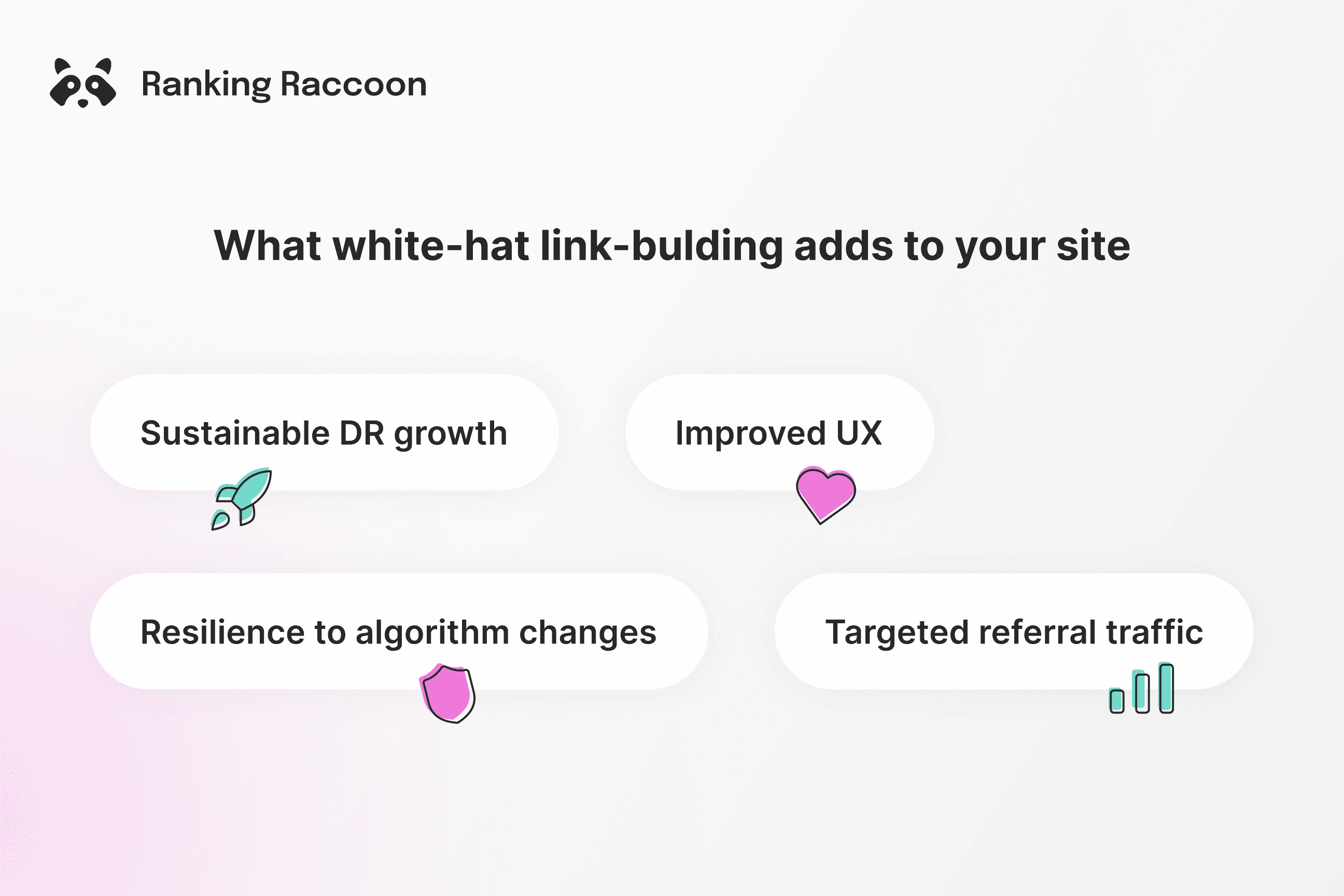
Keeping your link-building game within the white-hat realm might take a bit more time, but here’s why it’s worth it:
Sustainable DA growth
Ethical link-building helps increase your site's domain authority safely. Higher domain authority means better rankings and more traffic over time, all without risking penalties from Google.
"It's always worth it to opt for white-hat link-building if you aim for long-term gains.
People with short-term gain thinking always go for black-hat techniques but eventually, Google crawlers find out about those tactics and penalize your site."
SEO Specialist, Clickass
Improved UX
Quality over quantity is the name of the game with white-hat link-building. The content that earns links naturally is usually more informative and engaging, leading to a better experience for your visitors and potentially higher conversion rates.
Resilience to algorithm changes
White-hat strategies align with what search engines want, that's why they’re more adaptable to - let’s admit, very frequent - Google Updates.
This means you can have more peace of mind that another algorithm change won’t affect your site.
"Playing by the rules helps you stay on top in the long run and keeps you on Google's good side. This way, you build a strong and trustworthy online presence. Plus, you don't have to worry about sudden penalties or dropping in rankings when Google changes things up."
Rishabh Jain
SEO Specialist
Targeted referral traffic
High-quality backlinks from reputable sites don’t just boost your SEO; they also bring in targeted referral traffic. This traffic is more likely to engage with your content and convert, adding another layer of value.
How fast can I expect the results?
White-hat link building might take longer to show impact, but it’s the only way to ensure lasting benefits. Your rankings and traffic will steadily grow without the major risks that grey and black practices entail.
“It's crucial to approach white-hat link building with a long-term perspective and patience. Results depend on blog quality, domain authority, and niche competition. While some impact might be seen within weeks, the full effect of a high-quality guest post builds over time.
Focus on consistent, valuable content creation and relationship building with other sites for steady, sustainable growth in search rankings and referral traffic over months or even years.”
Dillon Loomis
Founder, Pinnacle Pursuit SEO
What are the best white-hat techniques I should follow?
Now that you know what white-hat link-building means, let’s take a look at the most effective white-hat link-building techniques out there.
All these techniques revolve around one main strategy: developing high-quality, original content that resonates with your audience and attracts backlinks naturally. 75% of the SEOs polled by the renowned SEO expert Aleyda Solis share that the most cost-effective link-building tactic for them is industry research, infographics, stats, trends, and case studies.
1. Digital PR, or building relationships with journalists
More and more sites turn to digital PR to earn authoritative editorial links.
To make it work for you, create compelling data studies and stories that journalists want to cover and link to.
One effective PR strategy is using outreach platforms like Featured, which connects journalists with sources for their stories. By providing valuable insights or expertise, you can secure high-quality links that might not be attainable through traditional link exchanges.
Similar tools include SourceBottle, Qwoted, PitchRate, and others.
2. Participating in industry forums and communities
Forum link building involves participating in online forums and adding links back to your site within your posts. This can be done by contributing to existing threads or starting new discussions.
You need to know that many of these links will be ‘nofollow’ ones.
But don’t discard them! First, a truly natural backlink profile consists of a mix of followed and nofollow links. What’s more, the recent Google Leak confirmed that even nofollow links, if they come from a reputable, high-traffic site, can potentially pass PageRank. Finally, sites like Reddit sometimes remove the "nofollow" tag on popular threads.
The benefits of forum link building go beyond followed backlinks and SEO perks. You can network with like-minded professionals, learn from others, raise brand awareness, and even do free market research by directly interacting with your audience.
How do you start with forum link building?
1. Choose the right forums
You can find niche-relevant forums by searching for “[keyword] + forum.” on Google. Then, check their site profiles in your favorite SEO tool. Look for high-domain authority forums with active members. If they allow do-follow links, it’s a plus. But as we said above, don’t shy away from nofollow links as they also bring value.
As an option, you can head to Ahrefs’ Site Explorer, enter quora.com, go to the Top pages, and search for a keyword. This reveals the most popular pages. If they're still open for answers, join the discussion.
2. Create your forum profile
3. Collect and bookmark questions that align with your brand and that you can answer with your expertise
4. Provide thoughtful, valuable responses using clear formatting, images, and relevant links
5. Stay active by answering questions and interacting with other members
The two best-known forums are, without doubt, Reddit and Quora. Both platforms have rather strict moderation rules, so you’ll want to strike a balance between self-promotion and genuine contributions to avoid a ban.
On Reddit, participate in subreddits related to your niche by commenting on threads and submitting original content. If your posts gain upvotes, they can drive significant traffic to your site. On Quora, answer relevant questions and include links back to your site in your responses. Creating a Q&A thread on your site and participating in Quora Spaces are additional ways to build links and showcase expertise.
Here an example of how Xmartclock promoted their time tracking software in a Quora discussion. Note that they not simply listed their own tool with a backlink at the beginning, but compared nine alternative products and gave tips on choosing the most suitable one.
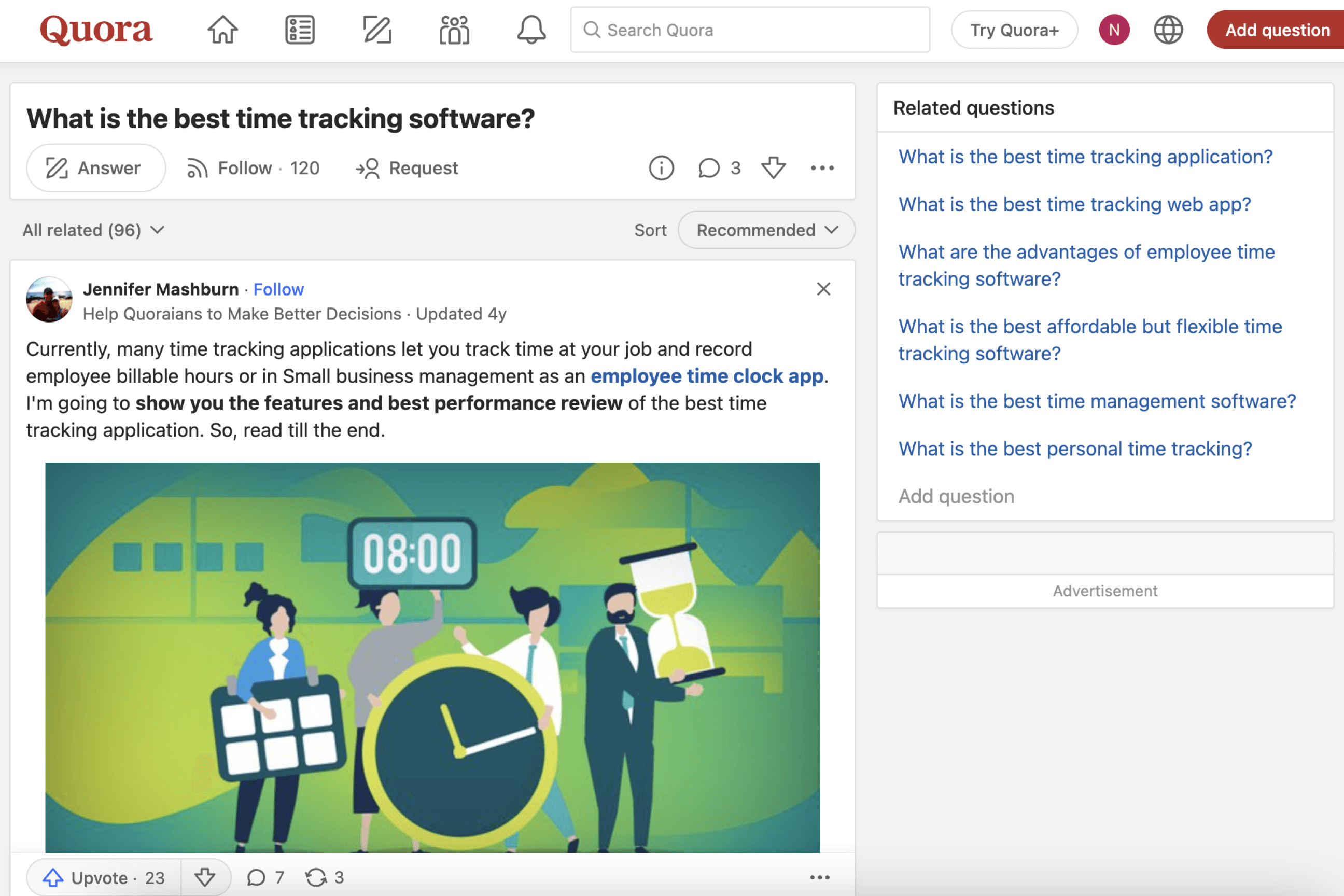
One caveat: avoid spamming threads with irrelevant links and refrain from overly self-promotional content. And of course, stay away from low-quality forums that can harm your SEO efforts.
3. Adding testimonials to other sites in your niche
Are there any tools that you use and love? Suggest that you add a testimonial or a full-fledged case study to their Customer Success Stories page. In most cases, you can receive a backlink to your homepage with a branded keyword as the anchor text. It’s a truly win-win tactic for both businesses.
For example, this is how Netconomy (the customer) got a backlink from Testlify (the tool).

You can also employ this tactic with your partner companies (e.g. tech integrations and distribution partners). This is a particularly helpful link-building strategy for SaaS. As an example, you can submit a quote to their existing case study that speaks about your mutual customer and get another backlink from it.
"Building backlinks for OutreachMani through personalized outreach and testimonials has been highly effective. The biggest challenge was securing high-quality placements, but persistence and new relationships paid off."
Founder, OutreachMani
4. Video content
Videos can be a game-changer for link-building if executed properly.
You can either produce videos from scratch or, if you ever held webinars, cut, edit, and repurpose parts of the recordings. To optimize your videos for search by incorporating relevant keywords in your titles, descriptions, and tags, and promote your videos through social media, partnerships, and niche-specific outreach.
"From my experience, videos are really a powerful means of attracting backlinks. Focus on crafting engaging content—such as informative how-tos or eye-catching animated infographics—and watch as valuable industry sites line up to link back to your expertise."
Dillon Loomis
Founder, Pinnacle Pursuit SEO
Let's see some examples for these two types of videos.
Educational or How-To Videos
These are helpful tutorials or explainer videos related to your niche.
Say, if your website is about home improvement, you could produce a series of videos demonstrating DIY projects or offering tips for common household repairs. Well-made, informative videos are likely to be linked to by other industry websites and bloggers as valuable resources for their readers. Alternatively, you can film a tutorial video on setting up and using complex software.
For example, the comprehensive Salesforce CRM Full Training Tutorial For Beginners video by CRMcrew got a backlink from several authoritative sites in the SaaS and Education industries - and a boost in organic traffic followed soon.
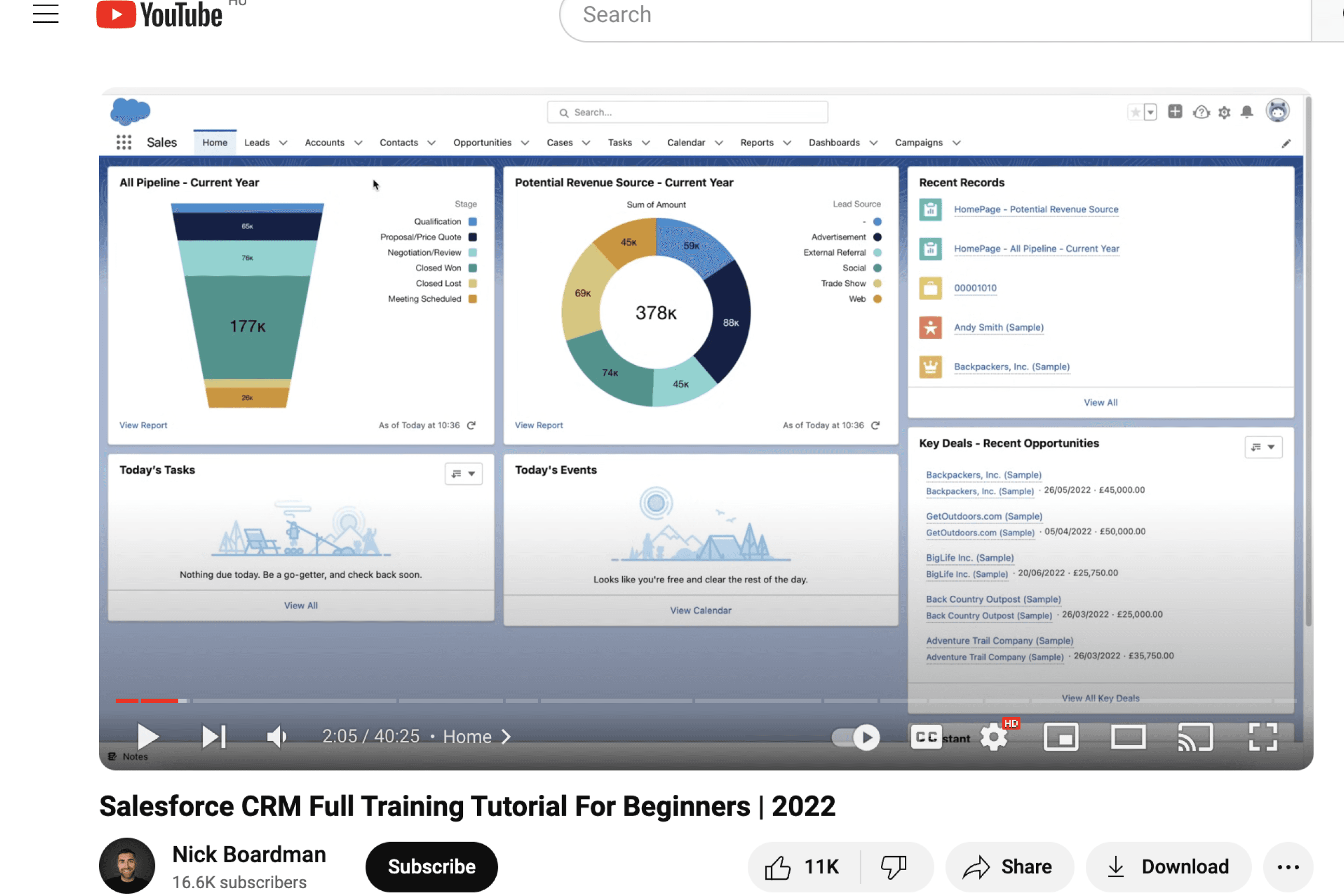
Animated Infographics or Data Visualizations
Transforming complex data or information into engaging, visually appealing videos can be a powerful way to earn links.
For example, you might create an animated infographic that simplifies recent statistics or trends in your industry, making the information easy to understand and share. If your video offers valuable insights or presents data in a unique way, it is more likely to be picked up and linked to by other sites.
To create videos easily, you may use tools like Movavi, CapCut, PowToon, DaVinci Resolve, or Adobe Premiere Rush.
Read more: 10 SaaS Sites That Got Link-Building Right
5. Broken link-building
Broken link-building is another popular white-hat link-building strategy. It works in three steps:
1. You find a broken link on a relevant website
The easiest way would be to add your competitor’s domain in Ahrefs' Site Explorer.
Then, navigate to the "Best by links" report. Set the HTTP code filter to ‘404 not found’. You will see the number of referring domains for each broken page - all sites that could potentially refer to you instead.
2. You create a better piece of content to complete the missing source (or browse existing content)
3. Finally, you ask the site admin to link to your content instead
In Ahrefs, you can see the referring domains and backlinks for each page by clicking on the "Links to page" dropdown.
For example, let’s say you’re an EOR platform and compete with Remote.com. You see from the ‘Best by links’ report that the link to Remote’s blog post ‘Why You Should be Doing Async Work’ is broken, but 22 domains still link to it from a total of 50 pages. In the best scenario, this could translate into 22 new referring domains to your own site.
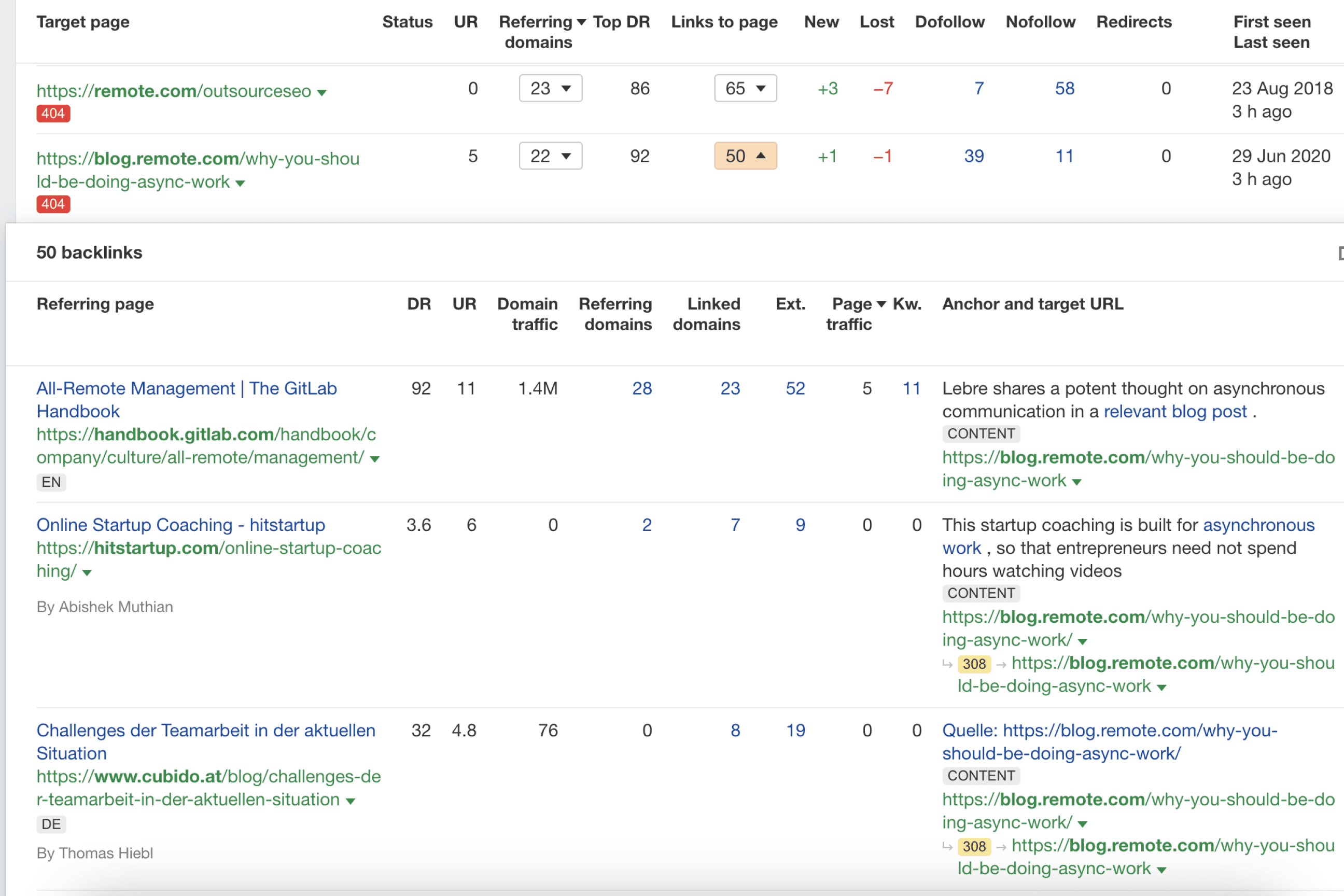
6. Unlinked mentions
Sometimes people talk about you without giving you the credit you deserve. In the content marketing world, that means mentions without links.
Unlinked mentions are link-building gold. The content manager is already familiar with your brand. You have the perfect reason to reach out and politely ask them to turn that mention into a link.
How do you find these hidden gems?
You can identify unlinked mentions by simply doing a Google News search for your brand name, founders, and execs - and then you can ask for a backlink. To stay updated whenever your brand name pops up online, set up a Google Search alert. You can also use tools like Mention, Brand24, or BrandMentions for notifications.
Alternatively, if you’re on Ahrefs' Standard plan and higher, you can take advantage of Content Explorer. Content Explorer allows you to search any topic across 14.4 billion pages. Apart from SEO metrics, it shows content-related details like authors, publication dates, and word counts.
This is how it works on Ahrefs:
1. Enter your brand name in the search bar
3. Apply the operator `-site:yourdomain.com` to exclude brand mentions from your own site
4. Filter by domain: toggle the one article per domain" setting to get a cleaner list
5. Enter your domain in the "Highlight unlinked domains" filter to see which sites haven't linked to you yet
6. Export results
Well done! Now you have a targeted list of potential link opportunities.
7. Lost link reclamation
You're probably losing backlinks all the time without even knowing it.
Established sites might be losing tens of thousands of backlinks every month, like in this example.
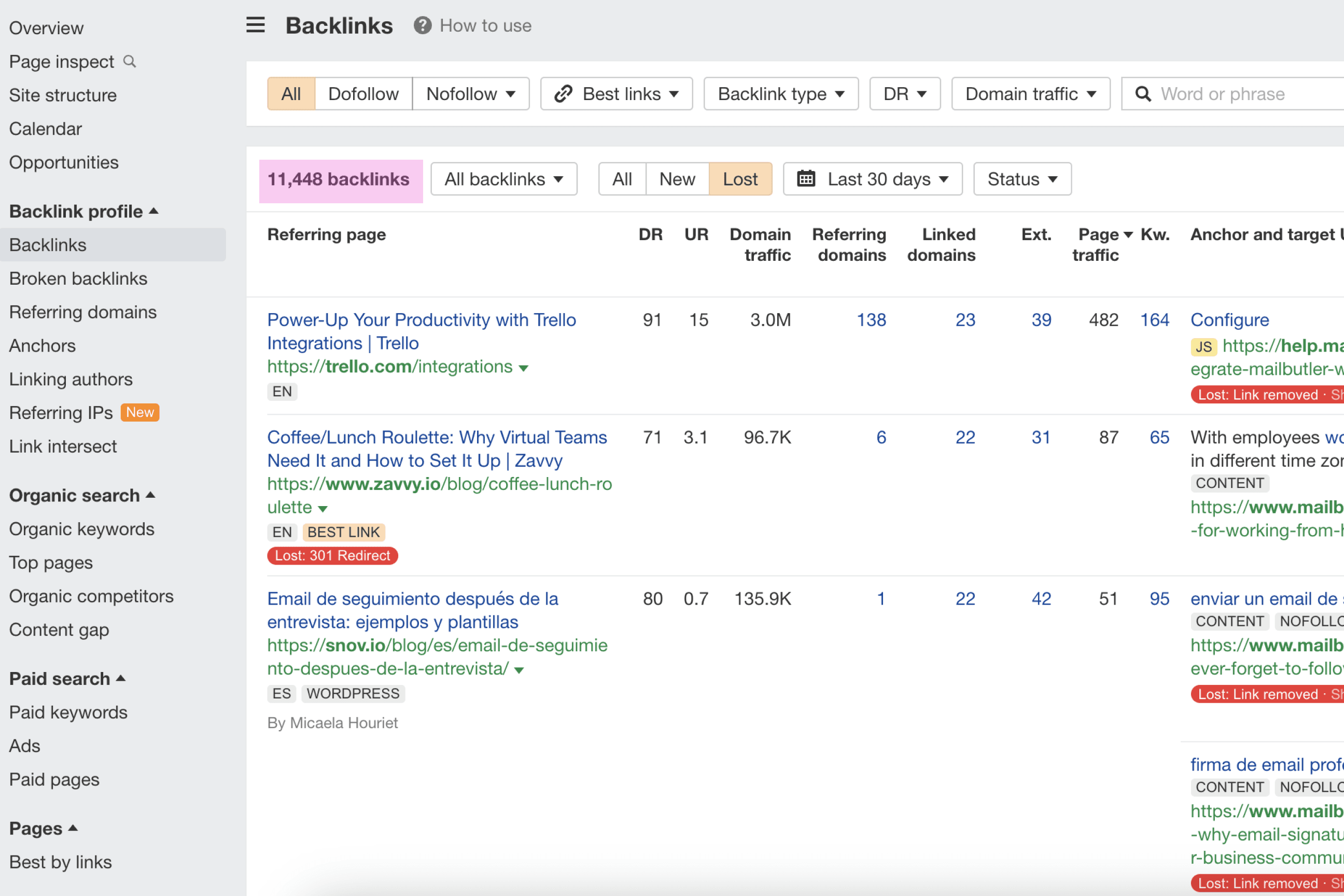
Lost link reclamation must be one of the lowest-hanging fruits in link-building while remaining a purely white-hat practice.
Why do links vanish? It’s either because the whole page disappeared, or the page remained, but your backlink was removed. Often, it gets deleted because the content was revamped. Check the URL to see if only the backlink or the mention of your site altogether was removed. If the latter is the case, see if your link fits the new content and politely suggest that the partner add it back.
Finding lost links is very straightforward:
- Go to Ahrefs' Site Explorer
- Enter your domain
- Go to Backlinks
- Select Lost and Status: Link removed
In this JetBrain's example, you can see who removed the link to their site. Filter the domains by DR and organic traffic to decide whom you should reach out to as a priority.
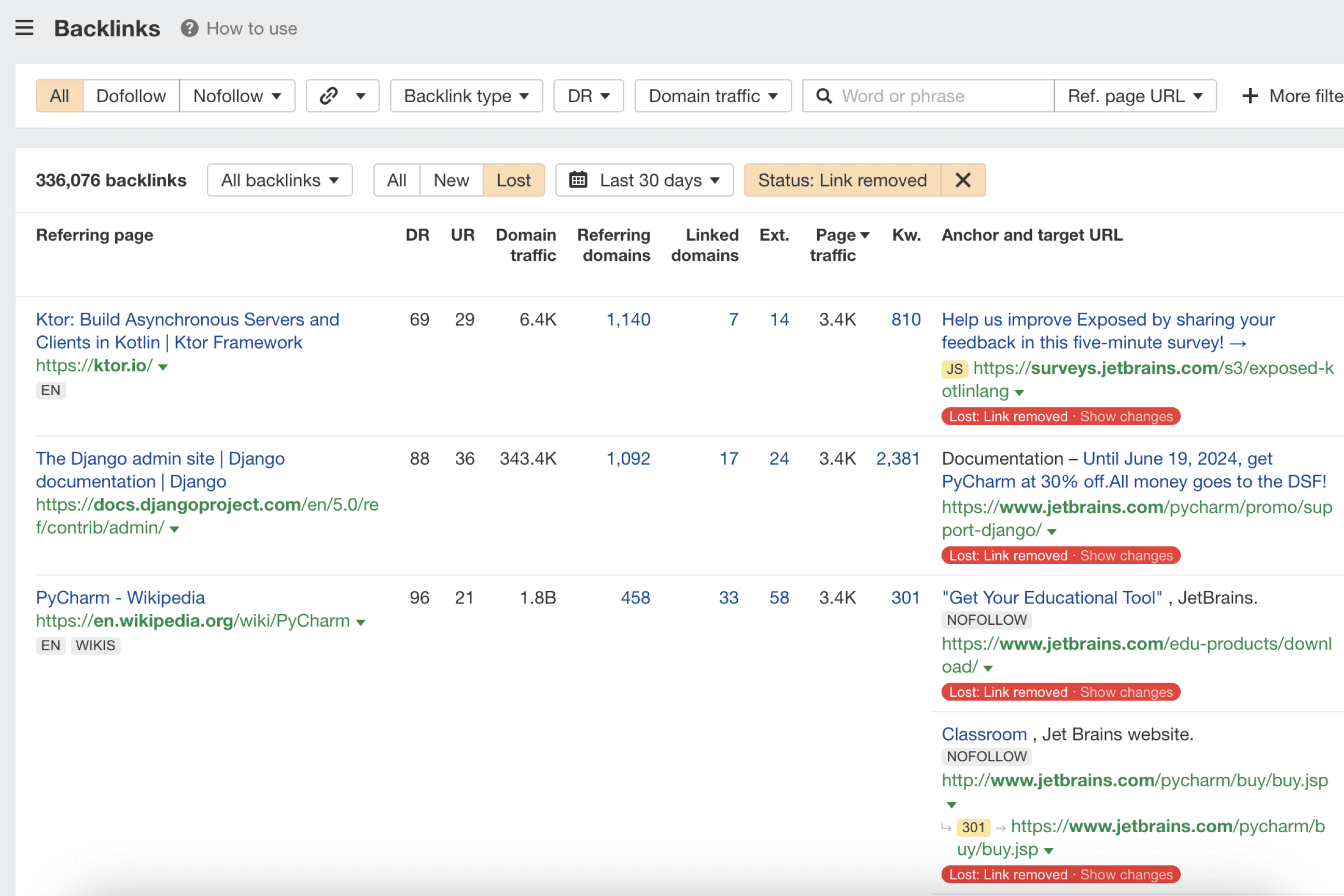
8. Internal links combined with external links
Internal links are one of the most underestimated parts of SEO. For amazing results, experts advise combining them with the power of external links.
Think of it as a system with interconnected elements. Start by creating a worthy top-of-the-funnel content piece. Design the piece to link to the middle-of-the-funnel and bottom-of-the-funnel content (e.g. comparison between your offering and competitors) and conversion pages where you want visitors to take action (e.g. sign up or purchase), on your site.
Then, pick a reliable link-building tool and start a link-building campaign for your top-of-the-funnel piece. Strong backlinks from external sources pass authority to this page, which will in turn pass link juice to the pages designed for conversion.
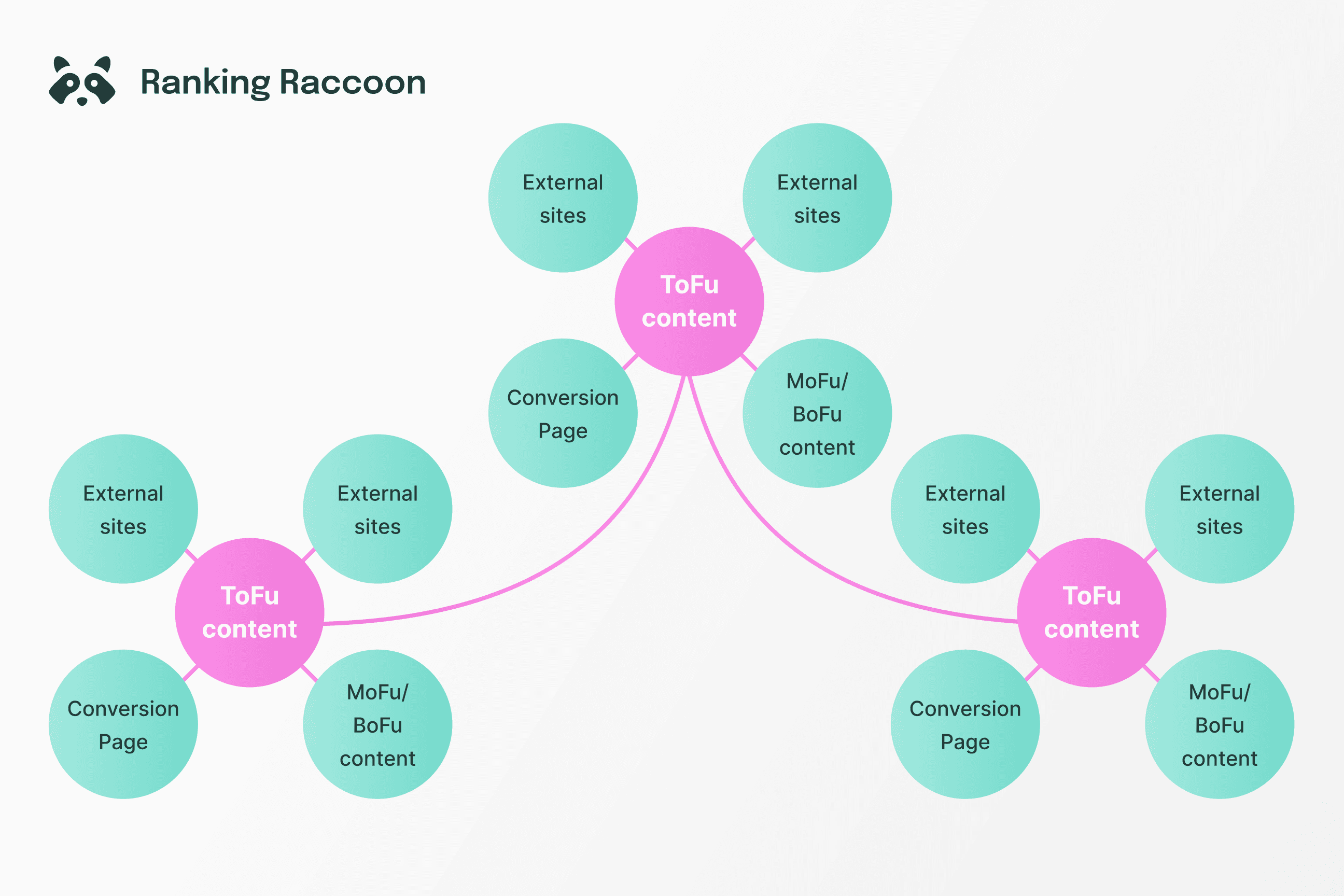
How could this work in practice?
Suppose you market a product that helps move large datasets from a source to a warehouse.
This is exactly what the Stitch platform is about. They published an insightful top-of-the-funnel article for digital marketers on the ‘14 key metrics in Google Analytics’. The blog post received 59 backlinks from 46 sources. In turn, this top-of-the-funnel article leads visitors to the pages where they can perform actions - such as trying Stitch for free or contacting sales.
Any other good practices to follow?
Lasting collaborations, patience, and strategic content creation - these are the three pillars of any sound white-hat link-building technique.
"To get juicy backlinks regularly, establish and maintain respectful relationships with other professionals.
On the technical aspect, you should build links to your target with a combination of contextually relevant anchors. Content should be around the topic of your target link!
From our team's experience, the best tactics for scaling organic growth & brand recognition are link insertions in listicle articles, expert roundups, backlinks from relevant niche sites, and guest posts that provide a natural mention."
Founder, GrowthMate
Conclusion
Navigating the ever-changing SEO world can be tricky, but sticking to white-hat link-building practices is worth it.
Although you might have to wait a bit longer to see the effect of white-hat tactics, the payoff is huge: steady growth, outstanding UX, and confidence when those Google updates roll in. At the end of the day, ethical strategies set up your site for long-term success.
With Ranking Raccoon, building backlinks the white-hat way is easier and faster than you’d think. We do the heavy lifting - the website and user verification - for you, so all you have to do is browse and send a link request to genuine site admins directly. Go the white-hat route with confidence, and watch your site go up in rankings with peace of mind.

Natalia Toth
Marketing Manager